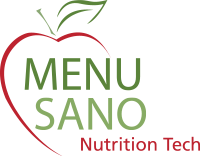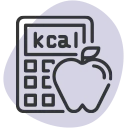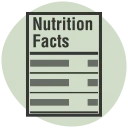Key Takeaways
- FDA regulations require specific fonts and minimum sizes for nutrition facts labels.
- Only legible sans-serif fonts such as Arial or Helvetica are allowed.
- The minimum font size is 6 point for most label formats.
- Formatting errors can result in FDA non-compliance and penalties.
- MenuSano automates FDA-compliant label formatting for U.S. food businesses with ease.
Why Font and Size Matter in Nutrition Labels
Typography is a foundational aspect of FDA-compliant nutrition labelling. The FDA has set clear and enforceable rules on what fonts and sizes are allowed on food packaging. The primary goals are clarity, legibility, and accessibility, enabling consumers to make informed dietary choices.
Though often overlooked, typography ensures legibility, transparency, and compliance. A label that fails to meet the mandated font standards can result in regulatory penalties, product recalls, or marketplace rejections. This comprehensive guide explores the approved font styles, required font sizes, spacing requirements, and how to streamline the process using cutting-edge nutrition analysis software like MenuSano.
FDA-Approved Fonts for Nutrition Labels
Accepted Font Styles
The FDA doesn’t require the use of a specific font for nutrition labels, but Helvetica is widely accepted as the industry standard. The FDA frequently uses Helvetica in its example labels, leading most manufacturers to follow suit. The main requirement is that the font must be easy to read. Bold elements such as “Serving size” or “% Daily Value” are usually in Helvetica Black, while the rest of the text is generally in Helvetica Regular. The “Nutrition Facts” title must appear in the largest font on the label.
Stylized, decorative, or cursive fonts are strictly prohibited, as they compromise legibility. Compliance standards demand a no-nonsense approach to font choice to ensure consumers can quickly access critical nutritional data.
Examples of Different Label Formats
Vertical Display with Micronutrients Listed Side-by-Side
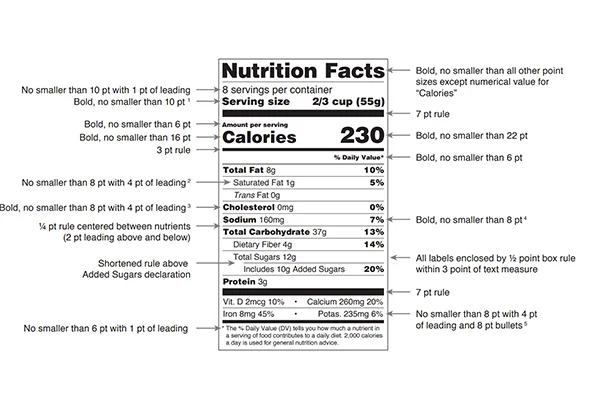
- Nutrition Facts: Bold, no smaller than all other point sizes except the numerical value for “Calories.”
- Serving Size: Bold, no smaller than 10 point
- Calories: Bold, no smaller than 16 point.
- Calories – Numerical Value: Bold, no smaller than 22 point.
- Divider: 3 point rule
- Micronutrients: Bold, no smaller than 8 point with 4 point of leading.
Tabular Format
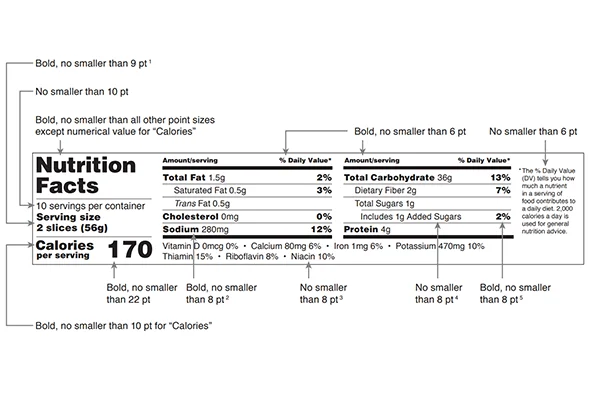
- Nutrition Facts: Bold, no smaller than all other point sizes except the numerical value for “Calories.”
- Serving Size: Bold, no smaller than 9 point.
- Calories: Bold, no smaller than 10 point.
- Calories – Numerical Value: Bold, no smaller than 22 point.
- %Daily Value: Bold, no smaller than 6 point.
- Micronutrients: Bold, no smaller than 8 point.
Dual Column Display, Per Serving and Per Container
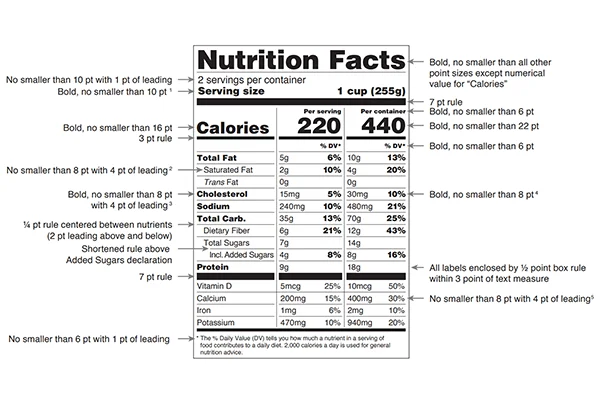
- Nutrition Facts: Bold, no smaller than all other point sizes except the numerical value for “Calories.”
- Serving Size: Bold, no smaller than 10 point.
- Divider: 7 point rule.
- Calories: Bold, no smaller than 16 point.
- Calories – Numerical Value: Bold, no smaller than 22 point.
- Micronutrients: Bold, no smaller than 8 point with 4 point of leading.
Linear Format for Small or Intermediate-Sized Packages (with nutrients in 8-point font)
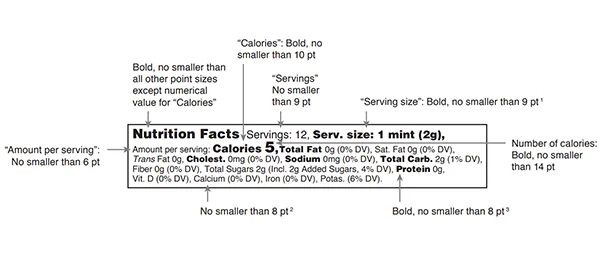
- .Nutrition Facts: Bold, no smaller than all other point sizes except numerical value for “Calories.”
- Serving Size: Bold, no smaller than 9 point.
- Calories: Bold, no smaller than 10 point.
- Calories – Numerical Value: Bold, no smaller than 14 point.
- Micronutrients: Bold, no smaller than 8 point.
Dietary supplement label containing multiple vitamins
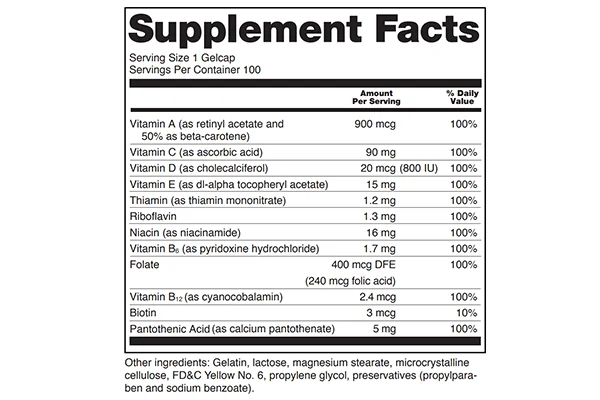
- Minimum font size for small packages: no smaller than 4.5 point for the “Supplement Facts” panel on the labels
- Minimum font size for intermediate-sized packages: The minimum font size is 6 points, except in certain cases: packages with 20 to 40 square inches of space that list over 16 dietary ingredients may use a font as small as 4.5 points. Similarly, packages smaller than 20 square inches may also use a 4.5-point type if they list more than 8 dietary ingredients.
- Tabular or linear format for an intermediate-sized package: A tabular format may be used if the shape or size of an intermediate-sized package doesn’t allow for vertical columns. A linear layout is permitted if the label still can’t fit a tabular format.
Avoiding FDA Non-Compliance with MenuSano
Creating a compliant nutrition label manually is risky and time-consuming. Missteps in font size or style—even by a fraction—can trigger compliance violations. This is where MenuSano comes in.
How MenuSano Ensures Font Compliance Automatically
With MenuSano’s Nutrition Analysis Software, food businesses can eliminate the guesswork. The software automatically generates FDA-compliant nutrition labels based on your recipe input. The system uses pre-configured templates that already meet FDA guidelines for:
- Font type
- Font size
- Bold formatting for key nutrients
- Proper alignment and spacing
- Bilingual label support
Enter your ingredients, measurements, and serving sizes. MenuSano handles the rest, instantly producing a professionally formatted, fully compliant Nutrition Facts or Supplement Facts Label.
Read more: Full Guide to CFIA-Compliant Nutrition Label Fonts and Sizes
Final Thoughts on Font and Size for Nutrition Labels
Creating compliant nutrition labels is not just about nutrition facts—it’s about presenting them correctly. Fonts and sizes are more than aesthetic choices; they are legal requirements that protect consumer health and ensure brand trust.
By following the precise rules for font style, size, spacing, and formatting, your business demonstrates a commitment to transparency and professionalism. With MenuSano, you can trust that every label is 100% compliant—automatically.
